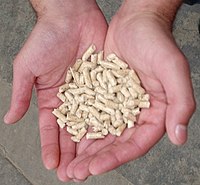
Photo from wikipedia
The objective of the reported project was to produce wood agglomerates from popular East European species to determine their strength and combustion properties. Closed-die pellets were produced from sawdust of… Click to show full abstract
The objective of the reported project was to produce wood agglomerates from popular East European species to determine their strength and combustion properties. Closed-die pellets were produced from sawdust of six types of wood common on the East European market: pine, willow, oak, poplar, birch, and beech. The properties of pellets, determined by the type of wood, were influenced by the compaction pressure and the moisture content of the sawdust. The highest average pellet density was obtained for oak sawdust, while the lowest density was obtained for poplar pellets. Expansion of pellets after removing from the die was found to be dependent on the wood species, and as expected, on compaction pressure. The pellet expansion increased after 2 h of conditioning in the laboratory and with an increase in moisture content. The highest and the smallest strength were obtained for oak pellets and for birch sawdust, respectively. The strength of the pellets increased by more than 100% with an increase in the compaction pressure from 60 MPa to 120 MPa. The average strength decreased by 65% with increasing moisture content. For all tested materials, drop resistance remained at a high level, acceptable in industrial practice. The highest calorific value of 18.97 MJ/kg was obtained for pine pellets. The highest ash value of 1.52% was obtained for willow pellets and the lowest value of 0.32% for pine pellets.
Journal Title: Materials
Year Published: 2021
Link to full text (if available)
Share on Social Media: Sign Up to like & get
recommendations!